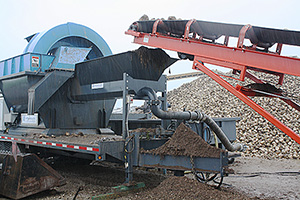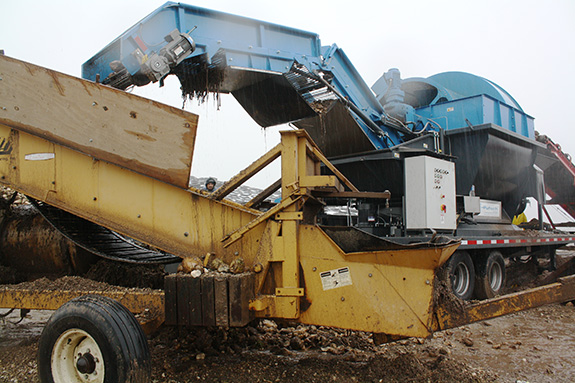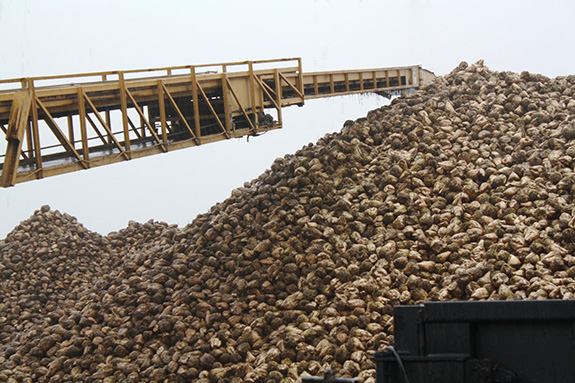This article was #15 of the Top 25 most well-read articles on www.progressivedairy.com in 2014. It was published in the Nov. 12, 2013 Extra e-newsletter. Last year, Betley Farms LLC of Pulaski, Wisconsin, harvested their first crop of sugar beets. While beet byproducts are commonly fed on dairies located in the sugar beet-producing regions of the country, Betleys’ beets were a specific hybrid geared for dairy cow nutrition.
They planned to chip the beets down to bite-sized chunks and incorporate them into the lactating cow ration as a source of sugar and highly digestible fiber.
 :
:
The ration is about to get sweeter at Betley Farms LLC of Pulaski, Wisconsin.
The 1,900-cow dairy owned by Jeff and Jena Betley and Jack and Gloria Betley recently harvested their first-ever crop of sugar beets and will soon be substituting this root for some of the corn in their lactating cow diet.
While a non-traditional Wisconsin crop, sugar beets are not a new feedstuff.
According to Craig Talley, animal nutrition technology lead for sugar beet seed company Betaseed, European dairymen have fed them for decades, and in the U.S., dairies within close proximity to sugar beet processing facilities have leveraged the nutritional value of the de-sugared byproduct, beet pulp, as a highly digestible fiber source.
However, the cost of trucking has been the limiting factor in its widespread use as a feed ingredient.
The Betleys are removing that access barrier by growing beets themselves. In May, they planted 60 acres of Feed Beets, Betaseed’s trademarked hybrid geared for dairy cows. As opposed to feeding beet pulp, working with this root crop in its whole form will allow them to tap into its full range of benefits.
“Beet pulp is a highly digestible fiber source, but this is a nice fit because it provides a sugar source with a digestible fiber,” Talley says.

Harvesting and handling
Harvesting and handling these fist-sized roots requires some equipment specific to the sugar beet industry. The beets were pulled from the ground with a traditional sugar beet harvester in late October, after the root temperature reached 55°F. They were then trucked to the dairy to be cleaned and destoned.
Talley worked with the Putsch Group, a German company specializing in sugar beet equipment, to bring a unit on-site for this task. The beets came off of the truck and were conveyed into the drum-like machine to minimize rocks and knock loose soil from their surface. Another conveyor system delivered the beets to a pile on the feed pad, where they can be stored uncovered for up to five months.
“We store them whole because that is how they are stable,” Jeff Betley says, referencing his mountain of beets. “Once we need them, in our instance, we will chip them.”
He plans to use a chipping machine manufactured by the Putsch Group to whittle the beets down into bite-sized chunks. This may be done immediately before feeding or in advance; in colder climates, a supply of beet chips may be stored for several weeks in a pile or commodity barn.
According to Talley, other chipping and storing methods for sugar beets are being tested for applications in both the dairy and beef industries. Beets can also be chipped down to the desired size of .5- to 1-inch using a bale grinder or side-slinging manure spreader. Trials are further looking into the possibility of bagging beets or ensiling in a bunker.

Feeding
Betley works closely with his dairy herd nutritionist, Bill Matzke, Matzke Dairy Consulting. Matzke believes this alternative to corn-based products in the lactating cow diet will offer attractive benefits, particularly to early lactation animals.
“We expect to feed 7 to 10 pounds of dry matter (DM) from beets, and that will replace approximately 2 to 3 pounds of DM from [high moisture] corn and about 3 to 4 pounds DM from corn silage,” says Matzke.
Maintaining the herd’s impressive 102 pounds of milk per cow, per day average is important. Though Matzke does not foresee beets interfering with production, he is interested to track the effect on components.
“We’re curious to see if we can influence protein,” he adds.
From an animal health standpoint, Matzke believes the addition of beets will further improve rumen function as a result of pectin, which naturally acts as both a buffer and an energy source.
“Ultimately, we are all about healthy animals, and beet pulp is something we feel is very beneficial from that aspect,” he says. “In this case, we are able to feed the whole beet. The value of the pectin in feed beets is huge, and we get the sugar with it. That’s a win-win.”
Plans for whether or not to plant sugar beets next year at Betley Farms are yet to be determined, but so far, this alternative crop is penciling out. Despite delayed spring planting, the beets averaged 35 tons per acre – yielding a total of nearly 2,000 tons of beets for the dairy.
“We will know in a month or two whether or not we want to do this again,” says Betley. “Looking at the cost of production from the input side, it is in the $20 to $25 per ton range. I should be able to grow a crop of corn or a crop of beets at about the same cost per acre.” PD
Click here to read a Progressive Dairyman article about a dairy farmer in Arizona who is growing beets as a ration, and watch a video about how the beets are processed.
PHOTOS
Top: Betley Farms recently harvested 60 acres of sugar beets that will replace some of the corn in the ration. After being pulled from the ground, the beets were trucked to the dairy to be cleaned, destoned and piled.
Center: To reduce the amount of ash that could end up in front of the cows, stones and excess soil must be removed from the beets. This was done at Betleys using a destoning unit sourced from Germany.
Bottom: Yielding 35 tons per acre, the Betleys have nearly 2,000 tons of sugar beets piled on their feed pad. Prior to feeding, the beets will be chipped down to bite-sized pieces, and then mixed in with the TMR. Photos by Peggy Coffeen.







